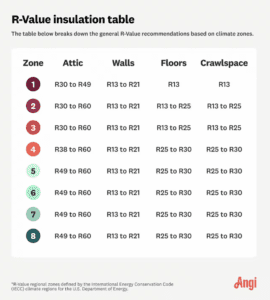Have you ever felt the icy hand of winter creep through your walls, or the stifling heat of summer radiate from your ceiling? If so, you’re not alone. Inefficient insulation can drastically impact your comfort and wallet, causing energy bills to skyrocket and leaving you battling uncomfortable temperatures. Thankfully, there’s a simple solution: understanding and utilizing R-values!
What are R-Values?
R-values measure a material’s resistance to heat flow. The higher the R-value, the better it insulates, creating a cozy haven indoors regardless of the weather outside. Think of it like a superhero’s shield: the higher the R-value, the stronger the shield against unwanted heat transfer.

Choosing the Right R-Value for Your Needs:
But wait, which R-value is right for you? It depends on several factors, such as:
- Climate: Colder climates require higher R-values. For example, an R-38 wall might be ideal in Minnesota, while an R-19 might suffice in Florida.
- Building type: Houses, apartments, and commercial buildings have different insulation needs.
- Type of insulation: Different materials, like fiberglass, rockwool, or spray foam, have varying R-values.
Decoding the Code:
Building codes often specify minimum R-values for different regions and building components. Check your local code to ensure your insulation meets or exceeds its requirements. Remember, exceeding the minimum can further enhance comfort and energy savings.
Beyond the Wall: Where’s the R-Value Love?
Don’t just focus on walls! Proper insulation extends to:
- Attics: A well-insulated attic keeps the heat where it belongs – outside in summer and inside in winter.
- Basements and crawl spaces: Insulating these areas prevents heat loss and moisture problems.
- Windows and doors: Drafty windows and doors can be major energy culprits. Consider energy-efficient options with high R-values.
Pro Tips for R-Value Champions:
- Hire a professional: Installing insulation properly is crucial for optimal performance.
- Seal the deal: Air leaks can negate the benefits of even the best insulation. Use caulk and weatherstripping to seal air gaps.
- Layer up strategically: Combining different insulation types in walls and attics can boost R-values and address specific needs.
- Go beyond R-values: Consider factors like soundproofing and moisture resistance when choosing insulation.
Remember, understanding and utilizing R-values is the key to unlocking a comfortable, energy-efficient home. So, grab your R-value superhero cape, arm yourself with knowledge, and embark on a journey towards a temperature-controlled haven!
Learn more about the Myth of R-Value and Spray Foam here:
*County code may have a minimum requirement lower than what is recommended. We will provide options for meeting code or meeting what is suggested due to climate. We always follow the direction and keep clients wants and needs in mind.
